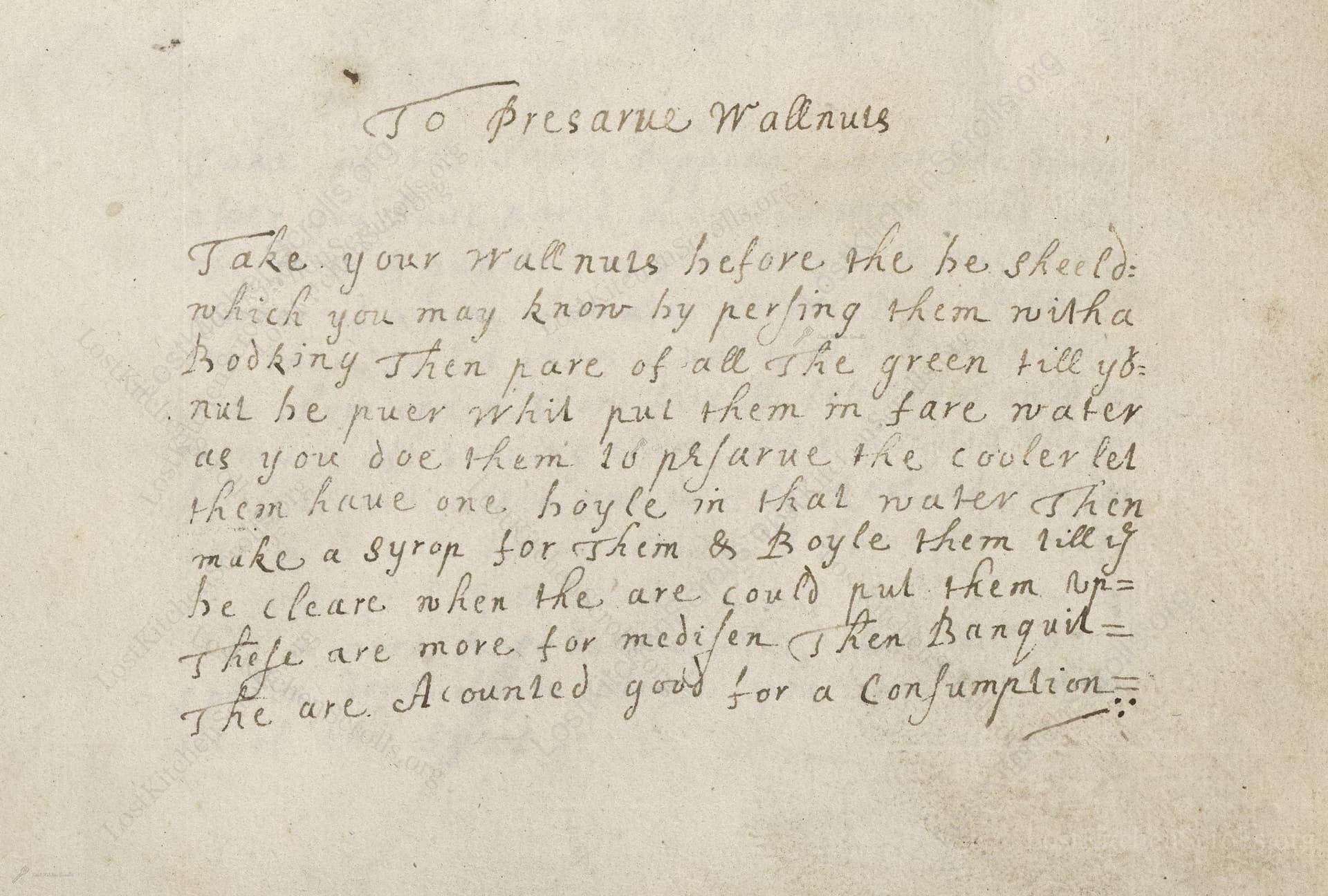To Presarue Wallnuts
From the treasured pages of Cookbook of Susanna Packe
Written by Susanna Packe

To Presarue Wallnuts
"Take your wallnuts before the be sheeld: which you may know by persing them with a bodking then pare of all the green till ye be puer whit put them in fare water as you doe them to presarue the cooler let them have one boyle in that water then make a syrop for them & Boyle them till yt be cleare when the are could put them up= These are more for medisen then Banquit= The are Acounted good for a Consumtion:."
Note on the Original Text
The recipe is written in early modern English, following a brief, imperative style common among manuscript collections of the period. Spelling is highly variable—'presarue' for 'preserve', 'wallnuts' for 'walnuts', and 'syrop' for 'syrup'—reflecting both dialect and the lack of standardized spelling in the 17th century. Quantities, timings, and precise temperatures are left to the cook’s judgment, relying on sensory cues: clarity of the syrup, color retention, ease of piercing. The recipe juxtaposes culinary instruction with health advice, a hallmark of recipes meant for both the kitchen and the stillroom.

Title
Cookbook of Susanna Packe (1674)
You can also click the book image above to peruse the original tome
Writer
Susanna Packe
Era
1674
Publisher
Unknown
Background
A delightful culinary treasure from the 17th century, this book offers a charming glimpse into the flavors and techniques that graced English kitchens in Susanna Packe's time, promising a feast of history and taste for any food enthusiast.
Kindly made available by
Folger Shakespeare Library
This recipe is drawn from the recipe book of Susanna Packe, dated 1674—an era rich in domestic medicine and seasonal preserving. Green walnuts were regarded both as delicacies and as medicinal foods, prized for their reputed benefits against 'consumption' (likely referring to tuberculosis or general wasting illness). The recipe sits at the intersection of early modern English banqueting traditions and household healthcare, reflecting both the ingenuity and the medical anxieties of the 17th-century kitchen. The clarification in the manuscript that the preserve is 'more for medisen than Banquit' offers a glimpse into the period’s beliefs: preserved fruits were considered both treats and potential remedies.

In the 17th century, this preserve would have been made using a sharp knife or paring tool for peeling, a metal bodkin (pointed skewer) to test ripeness, and a large cauldron or kettle over an open hearth for boiling. Earthenware or ceramic bowls held the soaking nuts, and heavy iron pans were used to simmer the syrup. Storage was commonly in stoneware or glass jars sealed with waxed parchment or bladder. Simple wooden spoons or spatulas and linen cloths would be used throughout the process.
Prep Time
35 mins
Cook Time
25 mins
Servings
10
We've done our best to adapt this historical recipe for modern kitchens, but some details may still need refinement. We warmly welcome feedback from fellow cooks and culinary historians — your insights support the entire community!
Ingredients
- 1 lb 2 oz young, green walnuts (early summer; before the shell forms)
- 2 cups water, plus extra for boiling
- 1 lb 2 oz granulated sugar
Instructions
- To preserve green walnuts, first gather young, unripe walnuts before they develop their hard shells—usually when you can pierce them easily with a skewer.
- Peel away all the green outer skin until you reach the pure white nut inside.
- Place the peeled walnuts in a bowl of clean water as you go, which helps preserve their pale color.
- Once prepped, give the walnuts a quick boil in fresh water for about 2 minutes.
- Next, drain and set aside.
- Prepare a simple sugar syrup by dissolving sugar in water (about 1:1 ratio by weight), bring it to a simmer, and add the walnuts.
- Simmer until the syrup becomes clear and the walnuts appear translucent, about 15–20 minutes.
- Let everything cool, then transfer the walnuts and syrup to clean jars.
- Traditionally, these preserved walnuts were used more for medicinal purposes than as a sweetmeat.
Estimated Calories
180 per serving
Cooking Estimates
You will spend some time peeling the walnuts, then boil them briefly, and finally simmer them in syrup. The whole process takes about an hour, with hands-on prep and active cooking. Each serving has an estimated 180 calories, based mostly on the sugar used.
As noted above, we have made our best effort to translate and adapt this historical recipe for modern kitchens, taking into account ingredients nowadays, cooking techniques, measurements, and so on. However, historical recipes often contain assumptions that require interpretation.
We'd love for anyone to help improve these adaptations. Community contributions are highly welcome. If you have suggestions, corrections, or cooking tips based on your experience with this recipe, please share them below.
Join the Discussion
Rate This Recipe
Dietary Preference
Main Ingredients
Culinary Technique
Occasions

Den Bockfisch In Einer Fleisch Suppen Zu Kochen
This recipe hails from a German manuscript cookbook compiled in 1696, a time whe...

Die Grieß Nudlen Zumachen
This recipe comes from a rather mysterious manuscript cookbook, penned anonymous...

Ein Boudain
This recipe comes from an anonymous German-language manuscript cookbook from 169...

Ein Gesaltzen Citroni
This recipe, dating from 1696, comes from an extensive anonymous German cookbook...
Browse our complete collection of time-honored recipes



